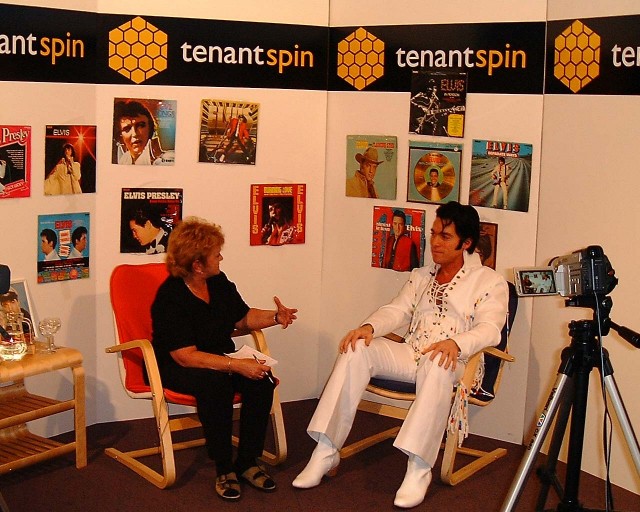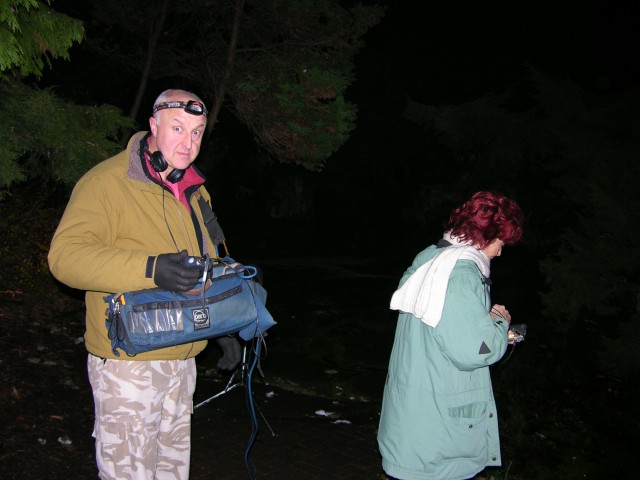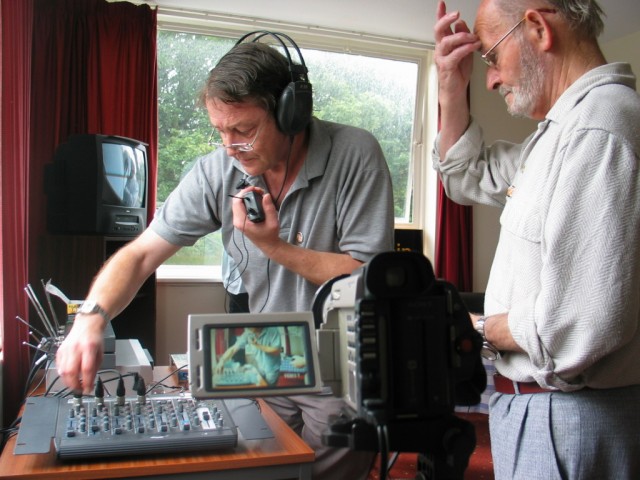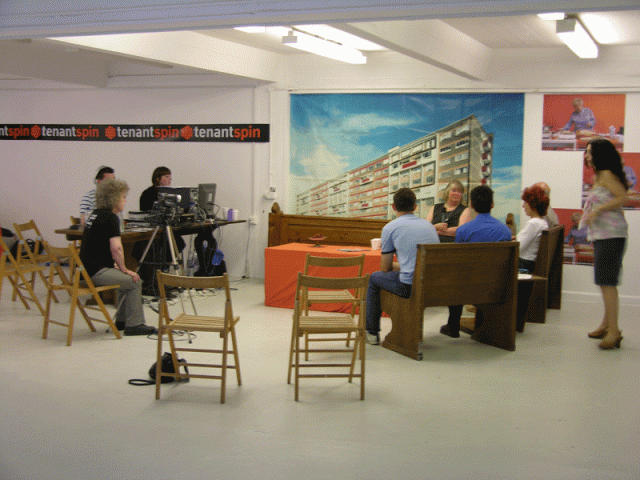FACT At 20: Before Assemble, tenantspin Reframed Liverpool’s Housing Crisis

As FACT celebrates its 20th birthday, Laura Marie Brown looks back at one of the arts organisation’s definitive projects: when artists from around the world trained residents in Liverpool’s high rise flats to become producers and presenters of their own TV show. As subversive as video art had been, and tackling deeply divisive topics, tenantspin used early Internet tools, finds Brown, to make stars and pioneers of its co-creators…
“You made it what it was,” reads the final caption on End of Transmission, the last tenantspin film. Marking the end of its groundbreaking broadcast, the ‘Liverpool-based community-driven Internet TV project co-managed by FACT (Foundation for Art and Creative Technology) and Arena Housing’ – ran from 1999 to 2013, and was funny, surreal, honest and empowering.
tenantspin began pre-social media, in the Internet’s feisty adolescence, before it became all jaded and aggressive. Back then, before citizen journalism was a phrase, joke and a punchline, it was hoped digital media would not merely speak truth to power but provide a level field with it. tenantspin brought some of Liverpool’s most disenfranchised citizens face-to-face with those who had real control over their lives, with web-casts and events, including meetings with local politicians. Why did it begin, why was it brilliant, and why hasn’t it been brought back?
tenantspin’s base was Coronation Court, Sparrow Hall estate, in Walton, North Liverpool, a now-demolished grey and imposing tower block built in 1956. Seven miles from the city centre, it was Liverpool’s first ‘ten storey flats,’ and would usher in a wave of 67 further high-rises across the skyline. By the end of the century, their future was in doubt and their residents were concerned about where, and how, they would live.
In 2000, FACT commissioned Danish artists group Superflex to develop the UK’s first ‘Superchannel’ in Coronation Court. Superchannel was a tool helping users to produce Internet TV (way before YouTube and live streaming was part and parcel of daily life). Superchannel was a network of local studios, meaning that users could create and evolve their own content, with live productions where audience and producers could chat and interact. In partnership with the Liverpool Housing Action Trust (HAT) the pilot became a long term project called tenantspin.
Looking back at that first commission over ten years later, one of the artists at Superflex, Bjørnstjerne Christiansen, says the digital technology of a web channel provided a voice for tenants who wanted to know what would happen to their homes. “Tenants could see,” he says, “what was going on behind the scenes.” They broadcast a board meeting of the housing trust to the TVs in the flats within the blocks and online, providing direct access for the tenants into policy processes that would decide their futures.

Through tenantspin, residents could ask fundamental questions about what their changing neighbourhoods would look like, and crucially, have some say in how they would be shaped.
What began as a tool to help tenants evolved into an online TV channel, encompassing all of the city’s tower blocks, with the tenants as producers and presenters, and artists collaborating on bespoke projects. For Alan Dunn, who became lead artist in 2001, it became much more than simply a broadcast. “In my first few weeks at tenantspin I wondered about avoiding (or banning!) nostalgia. There were plenty of other great projects around the city based on reminiscing, and I wondered what would happen if we invited the tenants to instead think about today and tomorrow.”
The small idea would prove to be a vital one, rooting the tenants as agents of change with the capability to voice their opinions on a city shifting beneath them. It was an arts project, yes, but one that was intensely socially engaged with the opportunity to change mindsets as well as policy.
For FACT, tenantspin was a model for engaging elderly people, a sustainable and adaptable community project that would go on to create some memorable moments and commissions. Liverpool A-Z, for example, was a series of 26 films made by Kelly Mark and tenantspin. Filmed at a flat in Sefton Park, the project aimed to get to know Liverpool by talking to people whose names begin with the letters A-Z. The films were exhibited at FACT. A Winter’s Tale saw sound recordist and artist Chris Watson work with the tenants to record sound in Sefton Park and Liverpool city centre from 3pm to midnight. The two resulting 40 minute compositions created a portrait of human and animal conditions in Liverpool.

For HAT, and later the housing associations in the city that became involved, like Arena, it opened the door for tenants and housing providers to coexist, sharing ideas, experiences and practices.
Laura Yates, Head of Participation at Bluecoat, had worked at FACT since the building opened, first as front of house, and was later brought in to work on specific tenantspin projects.
“What we were trying to do was bridge lots of gaps, technology and tools, but the point was inclusion. I was interested in the voices of older people and the ‘thing’ was social housing. tenantspin was a trailblazing concept. It was never reliant on one member of staff, one artist or platform, instead it was helping people use the technology and conversation to connect.”
FACT had its roots in the subversive video art movement and the Video Positive festival, and moving into a building on Wood Street in 2003 risked shaving off its more grassroots rough edges. Yet it created a community-based collaboration that was talking about an inherently divisive and politically charged topic, like social housing, at a moment of profound change. tenantspin was as subversive as video art had ever been.
The late ‘90s and early ‘00s was the era of Pathfinder and New Heartlands, two deeply disruptive and controversial housing projects that were seen by many as tearing at the heart of traditional communities in Liverpool and beyond. The tension at its core was an ambition to build a new city, while many of those whose streets were being demolished, or were cited for demolition, saw it as social cleansing or gentrification at its very worst.
Pathfinder’s pace was astonishing in Liverpool. A programme to clear what was often viable housing, and its inhabitants, to renew areas led to widespread compulsory purchase orders, but a lack of investment meant that many lived in limbo for decades. Nowhere was this more evidently seen than in North Liverpool.
A 33-minute film produced by tenantspin, in partnership with Arena Housing Association, Anfield Changing, made by artist and filmmaker Kim Ryan, tracked the regeneration work in Anfield and Breckfield. It was honest and unflinching and controversial. Not all tenants opposed Pathfinder, and not all stakeholders wanted the process on camera. But at a moment of seismic change for local communities, the platform that was talking directly to residents was tenantspin, with its room for debate and discussion.

“These were big topics”, says Laura, “and what the technology did was to show us all how to discuss.”
There were two main strands to tenantspin: Ways of Living focused on community issues, like housing; and Ways of Seeing focused on art and creative practice. In a city in rapid transformation, against a backdrop of cultural reassessment – Liverpool was awarded the title of European Capital of Culture in 2003 for the year 2008 – tenantspin offered a voice to those who rarely had one in the modern city where ‘Livercool’ was focused more on a younger population who would grow into the new urban sprawl. These older people, older residents, were able to explore and reflect on the customs and traditions that had gone, while seeking their future place. It was intensely intergenerational and inclusive.
One of tenantspin’s most famous characters was John “Spoons” McGuirk, a former Merchant Navy seaman from Bootle, who became a tenantspin presenter. As comfortable interviewing rock legends and cultural icons (a rather surreal rendition of Lily the Pink with Mike McCartney featured on one webstream), to in-depth examinations of political theory, John offered something quite rare in art, says Laura: authenticity.
“It gave him a new lease of life,” she says. “tenantspin had an ethos of inclusivity and a collective voice, but with the power of individual creativity. With John, you watched someone become an artist.”
When John died in 2012, a livestream tribute from The Box at FACT was watched by people all over the world. John’s family expressed surprise, as they hadn’t known their father, grandfather, uncle and cousin had become such a star.
While tenantspin became a vital route for older people to have a voice and relevancy, culturally, it tied into a zeitgeist of wanting to incorporate older audiences, practitioners and technology into contemporary art and culture. From takeovers at the Museum of Liverpool and Tate Liverpool, complete with a full TV studio, ‘tenantspin on tour’ brought the concept to galleries and international conferences. It won awards and accolades. But by 2013, it was coming to an end. A moment of austerity, certainly, but also something more.

Artist Alan Dunn had left the project in 2007 and thought the landscape in social practice was changing. There was, he says, “less of an emphasis on funding ‘silver surfer’ projects and Arena wanted to reach out to younger tenants.”
It left a mark, though, and a legacy. Only two years after tenantspin ended, a housing-based collaborative project, Assemble, won the national Turner Prize for their work in Toxteth: another area deeply impacted by housing issues.
tenantspin’s demise leaves a marked gap. During Lockdown, for example, the power of tenantspin, to connect people locked in their homes, would have felt life-changing. At a moment when social housing is back on the political agenda, and the rights of communities to have a say over how – and where – they live are more important than ever, a collaboration between artists and tenants would provide a critical voice to those in charge.
In their 2013 film, End of Transmission, FACT founder Eddie Berg commented that the organisation “wouldn’t have had its character, spirit (and) identity without the tenantspin project, it became central to the FACT story.”
“It was the point,” says Laura Yates, “the heart of FACT.”
When you search for tenantspin on FACT’s website now, only two results come up. Google it and there are plenty of broken links. It is only tenantspin’s former team of producers that have managed to archive any of its videos and images as proof of its existence. Digital archiving, and how we preserve collaborative projects, is a bigger conversation, but for a project that was meant to be about using the internet to give voice, their lack of an online footprint seems a sad silencing.
At a time when any individual can use social media to disseminate their thoughts and opinions, on everything from fashion to football, the roots of this weird and joyfully collaborative project deserve a much firmer plinth. The socially marginalised and disenfranchised give time and energy to the arts to provide a conscience and compass. The early digital pioneers built on unusual foundations, but they broke ground in these artworks that went on to shape much of our modern digital landscape.
How far will we remember them, and refer to them once we reach Internet 4.0 or 5.0, if we struggle to find any of their work?
Coronation Court was demolished in the end. Its communities moved on, many continuing to contribute to tenantspin until they were no longer able to. Documenting change doesn’t always result in success, but sometimes the most important thing is that someone was listening.
Laura Marie Brown
tenantspin’s dedicated website can be found here at tenantspin.org
Images courtesy Alan Dunn, with thanks





